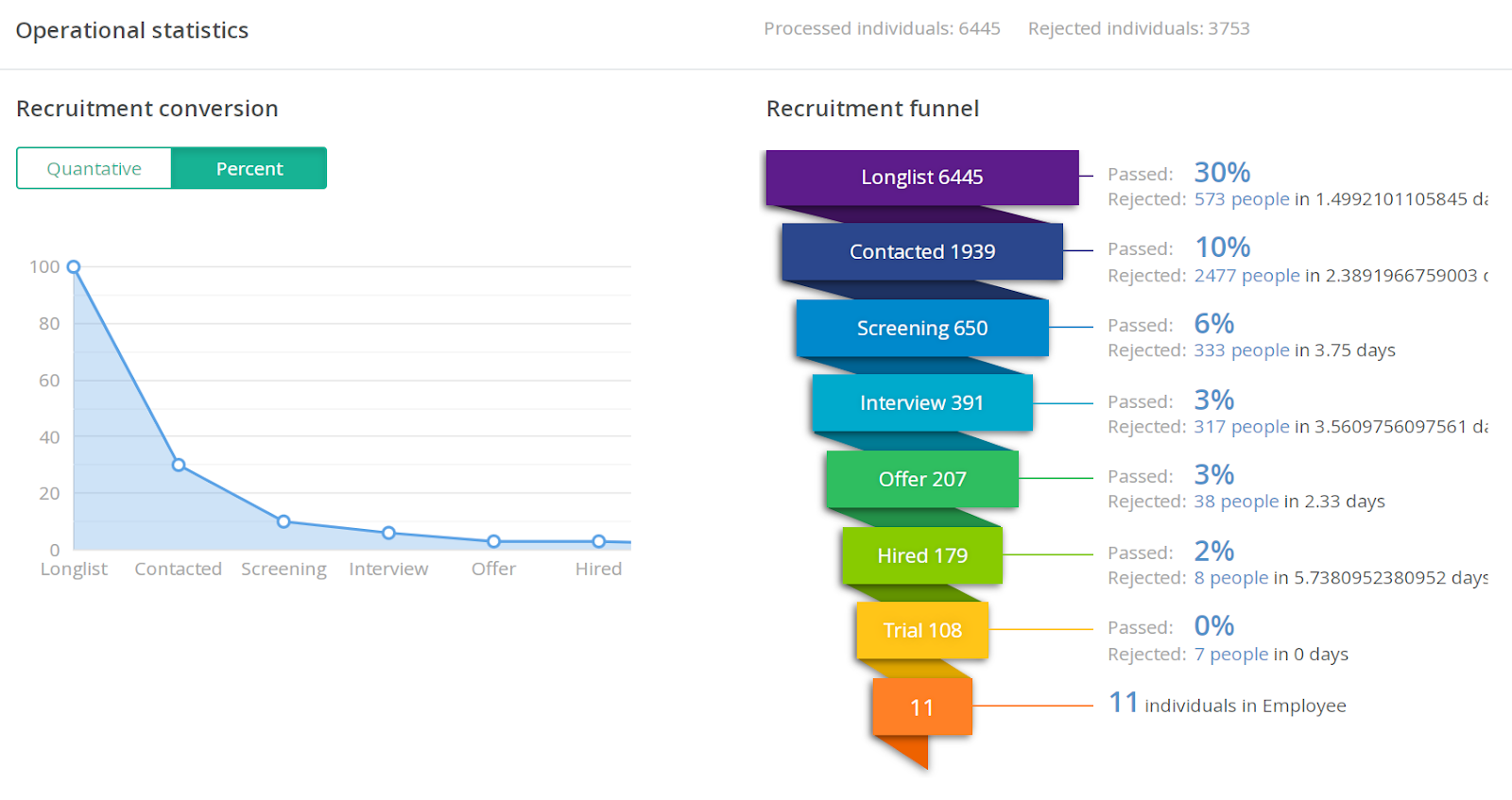Today, recruitment has become more technology-driven. Due to this, recruiters now have a significant amount of time to monitor, collect, analyze and report recruitment data. Recruitment has always been a challenging task. When you add various aspects of data analysis to the mix, things can definitely spiral out of control. As a recruiter, you would obviously want more value from your data to make smarter hiring decisions; in such cases, recruitment dashboards for businesses are considered the best solutions. Recruiting dashboards allow you to keep a close eye on key performance indicators (KPIs) and measure how impactful your recruitment strategy is on your business.
About SignalHire
Before we get to the gist of the material, let us look into the basics of SignalHire. SignalHire is a cloud-based HR analytics, recruiting, and benchmarking platform for HR departments and recruiting agencies.
This program is fitted with various analytical tools that help determine various facades of recruitment like recruiter efficiency, time to fill vacant job positions, cost per hire, and turnover rate. The candidate profiles are collected from public networks like job boards and can also be added manually from platforms like LinkedIn—you can install SignalHire on your browser using their extension. The pricing of the tool is very affordable as well.
What Is A Recruitment Dashboard?
A recruitment dashboard is a visual collection of data-driven metrics, reports, and key performance indicators (KPIs) that help you understand how your recruitment funnel is performing. This data includes budget, campaigns, hires, and applicants.
With the help of these metrics, your organization will be able to improve sourcing to find the best candidates for the roles, develop new talent acquisition strategies, and reduce recruitment costs. All these will have a positive impact on your entire business.
Importance Of Recruitment Dashboard
Here are some reasons why you should always invest in a recruitment metrics dashboard:
-
- See The Problem With More Clarity
One of the best benefits of using such a dashboard is the visual appeal. It is not easy to scout for patterns in a data set, and creating your own charts and tables can be very tedious. With the help of a dashboard, you will easily view insights, trends, and potential problems.
-
- Analyze Your Hiring Funnel
A recruitment funnel will allow you to look into your hiring funnel. You will be able to view how many applicants move on to the next stage. This way, you will be able to understand at which stage you need to improve the efficiency and effectiveness of the hiring process.
-
- Refine Your Recruitment Strategy
Let us consider an example, and you come across an issue while analyzing a hiring funnel. In this aspect, you will be able to look from where your most qualified applicants are coming from, and you will be able to refocus your efforts. This will save you a lot of money and allow you to hire more qualified candidates.
-
- Improve The Effectiveness And Efficiency For Your Recruitment
With the help of valuable data from the recruitment metrics dashboard, you will be able to make informed and better decisions and also improve your recruitment process. You will be able to spot alarming problems and solve them immediately. You will also be able to create a recruitment process tailored to the needs of your organization.
What Are KPIs In Recruitment?
Recruitment KPIs are measurement units that are used to measure the recruitment process and performance. You will see areas of improvement and show the return on investment and value for specific recruitment efforts.
KPIs for measuring the recruitment process and includes both unique and popular HR performance metrics. For instance, you can take a look at the productivity and cultural fit levels and other aspects like sourcing channel effectiveness, source of the hire, and the time taken for the entire hiring process.
How To Set KPIs For Recruitment?
So, what are some important KPIs for recruitment? You need to ask the following questions that will help you determine which KPIs you need to monitor to determine the value of your recruitment process.
- How often does it take to source the right candidates for a required job requisition?
- What is the time taken to recruit the right candidate for particular teams or jobs?
- What is the cost for identifying and engaging with qualified candidates?
- What is the number of qualified candidates that make it to the interview round?
- How many rounds of interviews it takes for HR to select the candidate?
- What is the time taken to recruit a qualified candidate?
- What is the rank of the compensation stacked against the competition?
- How is the recruiting process rated by the new hires?
- What is the number of internal referrals received for an open position?
As mentioned above, the volume of the data related to hiring and recruitment processes can be quite overwhelming. However, KPIs examine metrics like hiring-related costs, benchmarking against rival companies, measure improvement over time to help you see whether your efforts are working and what areas of your recruitment need improvement.
Top KPIs For 2021
Here are some important KPIs that you can use to measure performance:
Time To Hire
This is the KPI that measures the time when the candidate is contacted for the job and/or enters the recruitment funnel until the time they accept the job. This is an important KPI because it helps measure the efficiency of the recruitment process and identify potential problems. Keeping the time-to-hire needs to be as short as possible to boost the hiring quality and also lower cost. It will also inform hiring decisions for specific outcomes and timelines.

Sourcing The Efficiency Of The Channel
This is a KPI that can be used to measure the usefulness of your sourcing channels; in this case, channels refer to where you advertise your job openings. This will help you understand where you are getting the most qualified candidates and the return on investment from different sourcing pipelines. You can use conversion tracking tools like Google Analytics to view this data to develop effective sourcing strategies and improve the recruitment process.
Number Of Qualified Candidates
This is a KPI that can help you understand how effective your sourcing effects are in finding qualified candidates via the recruiting funnel. This is the ratio of selected candidates that make it through the first stage of the recruiting process. The best way to decide what makes a qualified candidate is by sending surveys or asking HRs whether candidates from the screening process are qualified or not. Or, you could make use of recruitment metrics like interview-to-hire ratio and referral rate to get an insight into the qualification of your candidates for specific job postings.
Submit to Interview Ratio
This is a KPI that takes a closer look at the number of candidates submitted to HR for potential interviews. If the ratio is higher, it could mean that there may be problems related to screening and sourcing; the screening and sourcing process should have an ideal ratio of 1:1. In such cases, you could start monitoring metrics like source of hire or hiring manager satisfaction if you cannot achieve the required KPI for the interview ratio.
Interview to Offer Ratio
Interviews are important components of the recruiting process. However, they can also be quite time-consuming. If the interview is unsatisfactory, it could mean a higher cost per hire. Optimally, the interview to offer ratio should be 3:1. If the average is higher, you need to ensure that the recruiting manager is reviewing or writing every job description. Next, you can start focusing on the screening and sourcing activities and KPIs like number of qualified candidates, sourcing channel efficiency, etc.

Offer Acceptance Rate
Once you can find qualified candidates and get them through the interviewing and screening process, you would want them to accept the job offer. In case they do not, the reasons may be that there may be some faults with your benefits and compensation strategy or with the company’s reputation. In such scenarios, you need to work with your finance team to have a proactive retention strategy so that you can boost the acceptance rate. You need to keep track of the compensation negotiations with the qualified candidates to make the required adjustments, and the pay is competitive.
Cost Per Hire
So, what is the cost of filling up a vacant position? This KPI is important for keeping track of all associated costs like attending job fairs, referral fees, and posting the job position on different job boards. You also need to consider the time taken by the HR recruitment team to hire and train new employees. In this aspect, you will have to look into areas where you can improve your efficiency. Additionally, you will also have to justify the retention efforts to minimize employee turnover.
Final Thoughts
With the help of recruitment KPIs, you will ensure that all your recruiting efforts are more cost-effective and data-driven. You need to make use of technologies to manage recruitment analytics, automate the process, and deliver advanced reporting features and data visualization.
Companies that use advanced HR management solutions can integrate recruiting data in real-time, along with financial analytics. The advanced dashboards will also enhance engagement, improve HR efficiency, and demonstrate the value of the recruitment efforts of the recruiting process.






